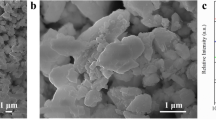SiC/SiC ceramic matrix composite parts have begun to be used in the hot section of gas turbine engines. It is essential to prevent atmospheric corrosion in these parts. Therefore, the development of coating materials with superior properties is of particular scientific interest. The thermal conductivity of coating ceramics is also essential for protecting parts in adverse high-temperature service conditions. In this study, ytterbium silicate-based (YbSi) ceramics used as the top layer in environmental barrier coating were produced by traditional powder metallurgy methods. In addition, they were doped with the rare earth elements Sm and Gd to improve some of their properties. The ceramic samples were structurally characterized by X-ray diffraction (XRD) and scanning electron microscopy (SEM). The thermal conductivity of rare earth elements–silicate samples was measured by the laser flash method. The characterization of samples allowed determining two phases in the rare earth elements–silicate pellets: mono- and disilicate. As a result of Gd doping, the percentage of the disilicate phase increased in the structure. Doping with Sm reduced the amount of this phase. The thermal diffusivity and heat capacity of YbSi ceramic were decreased by doping with Sm and Gd rare earth elements. Consequently, thermal conductivity was significantly reduced by doping Gd and Sm to YbSi ceramics. The thermal conductivity of undoped YbSi ceramics was calculated as 1.98 W(m ⋅ K)–1. However, the thermal conductivity values of YbSi ceramics doped with Gd and Sm amounted to 1.38 and 1.01 W(m ⋅ K)–1, respectively. As a result of Sm doping, the thermal conductivity of YbSi ceramic was reduced by 50%. Thus, RE-doped YbSi ceramics can be a promising candidate for environmental barrier coating applications.






Similar content being viewed by others
References
J.L. Smialek, R.C. Robinson, E.J. Opila, D.S. Fox, and N.S. Jacobson, “SiC and Si3N4 recession due to SiO2 scale volatility under combustor conditions,” Adv. Comp. Mater. 8, No. 1, 33–45 (1999).
E.J. Opila and R.E. Hann, “Paralinear oxidation of CVD SiC in water vapor,” J. Am. Ceram. Soc., 80, No. 1, 197–205 (1997).
K.N. Lee, H. Fritze, and Y. Ogura, Coatings for Engineering Ceramics. Progress in Ceramic Gas Turbine Development, ASME Press, New York, Vol. 2 (2003).
J.R. Price, M. Van Roode, and C. Stala, “Ceramic oxide-coated silicon carbide for high temperature corrosive environments,” Key Eng. Mater., 72–74, 13 (1992).
J.I. Federer, “Alumina base coatings for protection of SiC ceramics,” J. Mater. Eng., 12, No. 2, 141–149 (1990).
K.N. Lee, R.A. Miller, and N.S. Jacobson, “New generation of plasma-sprayed mullite coatings on silicon carbide,” J. Am. Ceram. Soc. 1995. Vol. 78, No. 3. P. 705–710.
Lee K.N., “Key durability issues with mullite-based environmental barrier coatings for Si-based ceramics,” J. Eng. Gas Turbines Power-Transac. Asme, 122, No. 4, 632–636 (2000).
K.N. Lee, D.S. Fox, J.I. Eldridge, D.M. Zhu, R.C. Robinson, N.P. Bansal, and R.A. Miller, “Upper temperature limit of environmental barrier coatings based on mullite and BSAS,” J. Am. Ceram. Soc., 86, No. 8, 1299–1306 (2003).
K.N. Lee, D.S. Fox, and N.P. Bansal, “Rare earth silicate environmental barrier coatings for SiC/SiC composites and Si3N4 ceramics,” J. Europ. Ceram. Soc., 25, No. 10, 1705–1715 (2005).
J. Felshe, “Polymorphism and crystal data of the rare-earth disilicates of type R.E.2Si2O7, J. Less. Common Metals, 21, No. 1, 1–14 (1970).
H.-F. Chen, C. Zhang, Y.-C. Liu, P. Song, W.-X. Li, G. Yang, and B. Liu, “Recent progress in thermal/environmental barrier coatings and their corrosion resistance,” Rare Metals, 39, No. 5, 498–512 (2020).
Tejero-Martin D., Bennett C., Hussain T. A review on environmental barrier coatings: History, current state of the art and future developments. J. Europ. Ceram. Soc. 2021. Vol. 41, No. 3. P. 1747–1768.
Rowles M., O'Connor B. Chemical optimization of the compressive strength of aluminosilicate geopolymers synthesis by sodium silicate activation of metakaolinite. J. Mater. Chem. 2003. Vol. 13. P. 1161–1165.
N. Al Nasiri, N. Patra, D. Horlait, D. Jayasselan, and W. Lee, “Thermal properties of rare-earth monosilicates for EBC on Si-based ceramic composites,” J. Am. Ceram. Soc., 99, 589–596 (2015).
E. Bakan, Y.J. Sohn, W. Kunz, H. Klemm, and Vaßen R, “Effect of processing on high-velocity water vapor recession behavior of Yb–Silicate environmental barrier coatings,” J. Europ. Ceram. Soc., 39, No. 4. 1507–1513 (2019).
M. Ridley, J. Gaskins, P. Hopkins, and E. Opila, “Tailoring thermal properties of multi-component rare earth monosilicates,” Acta Mater., 195, 698–707 (2020).
D.S. Smith, S. Fayette, S. Grandjean, C. Martin, R. Telle, and T. Tonnessen, “Thermal resistance of grain boundaries in alumina ceramics and refractories,” J. Am. Ceram. Soc., 86, No. 1, 105–111 (2003).
D.S. Smith, A. Alzina, J. Bourret, B. Nait-Ali, F. Pennec, N. Tessier-Doyen, K. Otsu, H. Matsubara, P. Elser, and U. Gonzenbach, “Thermal conductivity of porous materials,” J. Mater. Research., 28, No. 17, 2260–2272 (2013).
C. Wan, W. Zhang, Y. Wang, Z. Qu, Du A., R. Wu, and W. Pan, “Glass-like thermal conductivity in ytterbium-doped lanthanum zirconate pyrochlore,” Acta Mater., 58, No. 18, 6166–6172 (2010).
M. Beekman and D. Cahill, “Inorganic crystals with glass-like and ultralow thermal Conductivities,” Crystal Research Technol., 52, No. 10, 1700114 (2017).
Z. Qu, T.D. Sparks, W. Pan, and D. Clarke, “Thermal conductivity of the gadolinium calcium silicate apatites: Effect of different point defect types,” Acta Mater., 59, No. 10, 3841–3850 (2011).
Acknowledgments
This work was financially supported by the Scientific Research Projects Coordination Unit of Hakkari University, Grant number: FM18BAP16.
Author information
Authors and Affiliations
Corresponding author
Additional information
Published in Poroshkova Metallurgiya, Vol. 60, Nos. 9–10 (541), pp. 108–118, 2021.
Rights and permissions
About this article
Cite this article
Özçelik, Ö., Karabaş, M. & Yalçın, Y. Synthesis and Thermal Conductivity of Ytterbium Silicate Doped with Sm and Gd for Environmental Barrier Coatings Application. Powder Metall Met Ceram 60, 608–616 (2022). https://doi.org/10.1007/s11106-022-00273-1
Received:
Published:
Issue Date:
DOI: https://doi.org/10.1007/s11106-022-00273-1




